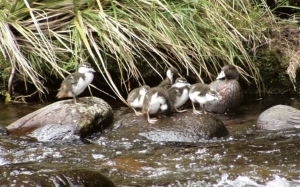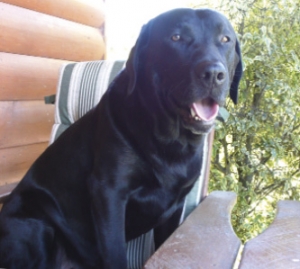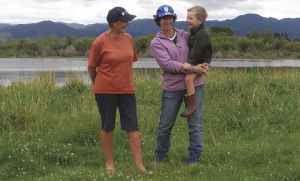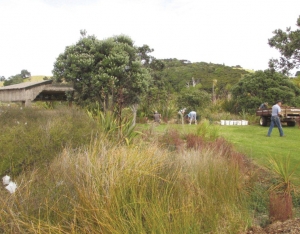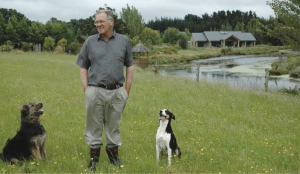Super User
Whio care pays off
Peter said that 33 captive birds have been bred this summer.
“It’s also been the best season in the wild that we’ve had.”
The birds had been hardened to fast flowing water at Peacock Spring ready to be introduced to real fast flowing rivers.
A hardening facility is planned at the National Trout Centre (see story page 12) which means less travel for North Island birds.
Each of these new birds has been micro chipped so they could be identified if found again.
Finishing school for whio
National Whio Recovery Group leader Andrew Glaser said the North Island whio rearing facility will help recover the national whio population by allowing whio ducklings to ‘grow and train’ in a more natural environment. “It’s like a finishing school for whio, where they can learn to swim and feed in fast flowing water, giving them a better chance of survival when they are released back into the wild.
“A facility like this will mean more ducklings survive the transition from captivity back to the wild, so they can establish their own territories and find mates. This will help us boost the population in the wild,” he said. Andrew pointed to the success of restoring the whio population in Egmont National Park which has been achieved through a combination of predator control activities and the release of captive reared birds over the past nine years.
“This is the first successful restoration of a whio population in New Zealand. It is a credit to the Taranaki community and shows what can be done with an effective trapping regime and WHIONE (lifting eggs and hatching and rearing in safe captivity).”
The whio population in Egmont National Park has grown from almost nothing to 24 pairs of whio since 2005. This breeding season a record 36 ducklings hatched in the park, although it’s not yet known how many of these will survive into adulthood.
Two whio rangers on the Manganui o te Ao River – searching for whio travel on unique water craft manufactured by our multi talented DOC rangers!
are located at Te Anau and at Peacock Springs near Christchurch. Using South Island facilities means extended travel for North Island whio ducklings. Constructing a low cost facility in the North Island reduces the
risk and expense associated with this.
The facility will cost an estimated $110,000 with funding from the Whio Forever
partnership, DOC and the Central North Island Blue Duck Charitable Trust.
Construction should be completed for the arrival of the first ducklings in September this year.
The support of Genesis Energy is enabling DOC to double the number of fully secure whio breeding sites throughout the country, boost pest control efforts and enhance productivity and survival for these rare native ducks.
Pukaha Mt Bruce news
Pukaha Mt Bruce news
Paintings at Pukaha
It started in March but continues to June 22 so you can enjoy an exhibition of native bird paintings at Pukaha Mount Bruce.
Entry to the exhibition is free of charge.
Mauriora update
In October 2013 Mauriora, the second white kiwi to be hatched at Pukaha Mount Bruce, was released into the Pukaha reserve. A close eye was kept on him and in February it was decided that his weight wasn’t being maintained. He was taken to Wildbase at Massey University where it was discovered he had ‘grass burrs’ in the roof of his mouth.
They were removed and his appetite quickly recovered.
He’s back in the Pukaha reserve and we’ll continue to keep an eye on him.
Bird numbers up at Lake Ellesmere
Bird numbers up at Lake Ellesmere – annual census
Society NZ, Department of Conservation, Christchurch City Council rangers, Fish & Game, Environment Canterbury, Ngai Tahu, Rotoract, Waihora Ellesmere Trust, and others.
BirdingNZ website tells us that February 22 was one of the hottest days of summer, over 40 people from a range of organisations undertook the counting of all the wetland birds on Te Waihora/Lake Ellesmere. You can see some of those photos on their Facebook page.
The count is a snapshot of the birds present on a specific day and for the species which occur in large numbers such as the ducks and geese, the numbers are estimated by experienced counters.
The total number of birds recorded is slightly down on last year, with just over 55,000, compared with around 55,700 in 2013. The numbers of waterfowl were down with just under 42,000 this year compared with around
45,000 in 2013. However, the numbers of waders were up with over 7300 recorded, compared with around 6100 in 2013.
Also notable is that 45 species were recorded in 2014 compared with only 39 in 2013. This year’s count recorded many more Arctic migratory species, e.g. greenshank and sanderling that were not seen in 2013.
With the very low lake level, the habitat for birds was of variable quality with some areas of the lake edge too dry. However, the lake edge is extensive and the habitat was very good in places leading to a redistribution of birds around the lake.
This copy courtesy of BirdingNZ, and Peter Russell. See www.birdingnz.net
Black Cormorant
Pied Cormorant
Little Cormorant
Spotted Shag
White-faced Heron
White Heron
Royal Spoonbill
Mute Swan
Black Swan
Canada Goose
Feral (greylag) Goose
Paradise Shelduck
Mallard/Grey Duck
Grey Teal
NZ Shoveler
Shoveler/G Teal
NZ Scaup
duck sp.
Australasian Harrier
Pukeko
SIPO
VOC
240
51
4
92
3
871
14
7473
3777
443
5148
5173
12504
5893
780
12
696
67
97
17
2
Letter to the WTA Editor
Lack of ducks – Where have all the mallards gone…?
On top of this it is now known that the aerial bombardment of 1080 is killing trout – and at the same time eliminating a highly lucrative tourist fishing industry and the huge income from the sale of trout fishing licenses by Fish & Game Councils.
Pre season practise for hunters
The special three weekend hunting season starting from Saturday, February 8 took place in the Manawatu/Wairarapa areas.
Fish & Game introduced the special season to assist landowners who have groups of birds feeding on new grass and crops. The idea was to disperse the ducks more than to bag them.
Paradise shelduck are known for moulting in groups on open water in January, and once the birds can fly again in February they tend to gather in large groups. They can often be seen in mobs of 200 or more on the lookout for food, and cause problems for farmers.
This special season was restricted to private land only. Public areas including DOC and Fish & Game land were not open during the special season. There was a five bird a day limit so the kill was modest.
The hunt succeeded in spreading out the birds and was seen as a good result.
National Rural Wetland Champions for 2014
To celebrate World Wetlands Day this year, the National Wetland Trust and the Department of Conservation (DOC) worked with regional councils to find New Zealand’s most wetlandfriendly farming families.
Wetlands are important to maintaining a healthy environment, playing a key role in water purification and flood control. Protecting wetlands and minimising the impact of farming benefits everyone.
Seven regional councils submitted nominations.
country.
Big Haywards Lagoon, for more than 150 years.
The judges said: “This farm ticked just about all the boxes for environmental best practice.”
wetlands, on the eastern side of Lake Wairarapa.
In their nomination the Greater Wellington Regional Council (GWRC) described Jane Donald, daughter Paula Gillett and their family - present and past - as role models for wetland restoration.
The GWRC praised the Donalds’ ability to marry their farming and conservation of their wetlands.
“Canny initiative and perseverance describe Jane and Paula’s approach to wetland development and protection. This land has a long association with farmers, hunters, conservationists, and local councils. The majority of the land farmed by the Tairoa partnership is protected by a QEII covenant with actively managed functioning wetlands.
wetlands and lakeshore and the dairying occurring inland separated from the wetland complexes. The farm and integrated wetlands provide a show case for not just protecting biodiversity and water quality but enhancing it in a most practical and innovative way by clever land managers using agricultural tools.”
• keep stock out of waterways and other
sensitive areas
• plant native wetland plants to restore habitat
• manage pests and weeds to enhance native wildlife
• design their culverts to ensure fish can
move freely
• carefully manage fertiliser and dairy shed effluent to minimise runoff and return nutrients to the land
• use a feed pad to reduce trampling by stock and erosion.
Pioneer Jane Donald has also pioneered aerial application of herbicide to control plant species such as willow and alder which were encroaching on the wetland her father had protected. This is now a commonly used, costeffective method for hard-to-reach wetlands. Done correctly, it controls the spread of introduced plant species enabling native plants to flourish and provide a habitat for native birds and other native wildlife.
The Donald farm is proof that this is a recipe for success. Jane and her family have been rewarded for their conservation work with abundant native wildlife in their wetlands. This includes the rare Australasian bittern (matuku), the first record of royal spoonbills (kōtuku
National Wetland Trust founder Gordon Stephenson said: “There’s a heap of initiatives and best practices here, in both farming and conservation. The Donald family are excellent role models for farmers. I’m delighted to see they share what they’ve learnt on their farm with the wider community.”
Highly Commended
The judges awarded a Highly Commended Certificate to the Gilder family of Otago for their work to protect wetlands on several Landcorp dairy farms they manage at Paretai near Balclutha. They have QEII covenants on the wetlands and fenced them as protection from stock. The Gilders are also planning wetland conservation measures on their own recently purchased block.
The judges were impressed with the Gilder’s best practice farming and involving their community and schools in their conservation work. Helen Gilder said, “It’s important to sow the seed of environmental importance into future generations.”
Jan Simmons of the Department of Conservation was delighted at the high quality of the nominations spanning the country. “These farming families show that profitable farming and environmental stewardship can go hand in hand. They are an inspiration.”
World Wetlands Day is celebrated on February 2, the anniversary of the Ramsar Convention on Wetlands of International Importance held in Iran in 1971. The theme for this year’s National Wetlands Day was ‘Wetlands and Agriculture: Partners for Growth’.
To learn more about wetland restoration visit www.wetlandtrust.org.nz
Riparian plan helps BoP farmer
purchased the property on his 21st birthday) and now his eldest son, Allen, manages operations.
The farm was originally rundown with leaky fences, rudimentary sheep yards, a basic woolshed and no cattle yards. About a quarter of the 300ha was covered in fern and manuka, and plenty of gorse.
Today the sheep and dairy grazing station has been heralded as a sustainable success. The former Meat & Wool Board monitor farm, and supreme winner of the Bay of Plenty Ballance Farm Environment Awards, has benefited from technology and environmental practices.
Jim said measures had been put in place on the farm located in the lower Kaimai Ranges, to preserve the fauna, flora and Mangakaiwhiria Stream that meanders through the property. Thousands of trees were planted, most waterways fenced and land around the stream
perseverance and hard work.
“When you retire land from grazing, you can have real problems. First, you need to have a substantial fence that is stock proof, and it’s advisable to run a hot wire at shoulder height to deter cattle from reaching through.”
Noxious animals and weeds were other problems, and although the gorse had been beaten any spraying done had to be judicious as there was the risk of killing replacement plantings. Regional council natural resources operations manager Warwick Murray said the council has been working for decades on land and waterway management.
Since 2009, 569 farmers have taken advantage of regional council assistance to improve water quality and farm productivity, he said. The riparian programme uptake was increasing year on year.
“This response has been terrific but we’d love to have more landowners on board,” Warwick said.
The Western Bay of Plenty District Council also provides funding for fencing in certain circumstances. Figures show stock has been excluded from 87 percent of the stream length within the Tauranga Harbour catchment, 83 percent of Ohiwa Harbour catchment streams and Nukuhou and Waiotahi Rivers, and 93 percent of stream margins in the Rotorua Lakes.
Tossi field day
Tossi field day
At the recent Volunteers Day at Tawharanui Regional Park, one of the tasks was to weed the new plants that had been put in last year beside the Bird Hide.
The Lagoon at Jones Bay has been very busy now with various water bird life and they are not at all worried about the Hide built there in 2013. It’s a great place to sit and enjoy the scene.
With the grassy area behind the Hide, a decision was made to disguise it with bush. So the volunteers planted low shrubs there last year.
Sadly a family of rabbits moved into the area and many of the plants have been eaten badly. So now netting has been used around individual plants. Also many of the rabbits have been discretely removed.
A trailer load of mulch has also been useful to place around the plants to keep them moist in the extreme summer heat.
Patte Williams
Change attitudes and improve the environment
Change attitudes and improve the environment
Into this area a few years ago stepped Ducks Unlimited member Ossie Latham, and his conscious was pricked by the degradation he saw in the waterways near his home.
Growing up on the banks of the Oroua River downstream from Feilding, part of a third generation on both maternal and paternal sides of his family he remembers: “During that time the Oroua had gone from a pristine small river where kids could swim in deep holes, dive off the road bridge, catch eel, trout and flounder, to a gravel choked conduit for industrial, town and farm waste. A dead waterway, the greatest degradation happened in my time as a kid,” said Ossie.
Then came concern for the Manawatu River and its’ tributaries of which the Oroua is one. The Manawatu River Accord was set up and out of that spun the Oroua Catchment Care Group. Ossie attended their meetings and the Oroua Group decided the best way to tackle the problems was to think catchment wide
but act local to address whatever issues may be in any given area. The Mangaone West stream where Ossie and wife Mary live is a tributary of the Oroua. Ossie volunteered to be champion for that area.
As a local champion his job was to gage the support of residents for a collective effort to address issues of farming and lifestyle practises that degrade the environment.
“Once sufficient interest was identified, we called a community meeting and established the Mangaone West Landcare Group.
Neil Managh, coordinator of the original group gave his support to Ossie who
then called on the leading farmers in the area, the local school principal, known
environmentalists, friends and acquaintances and got their commitment to the scheme.
“We organised a community wide pamphlet drop calling a public meeting and away we went,” Ossie said.
whatever we do to our landscape sooner or later affects our wetlands and waterways, I think it is worth DU members thinking about what happens upstream from their favourite dam, wetland or waterway.
About 60 percent of landowners are part of the group. All major farmers bar two are committed and interest is growing. There is a diversity of views on what best practise is and just what is sustainable but Ossie said they cope with this by agreeing that “Sustainability is the ability of the current generation to meet its needs, without compromising the ability of future generations to meet theirs.”
“I’m not sure where I got the quote from but it gained widespread acceptance to what we are on about.
“We recognise it’s taken over 100 years to get where we are now, so we expect our work to improve our chosen living spaces to be intergenerational. While the stream is our common bond, we love our landscape which the stream and we are part off.”
(Afterthought)
“After doing the question and answer bit for you I got to thinking, what is the key for many of the settler families who are part of our group? Many of them are 3rd and 4th generation; they have a strong sense of stewardship, a concept that is evolving as our knowledge of interdependence grows. It’s good to be part of their efforts.”


